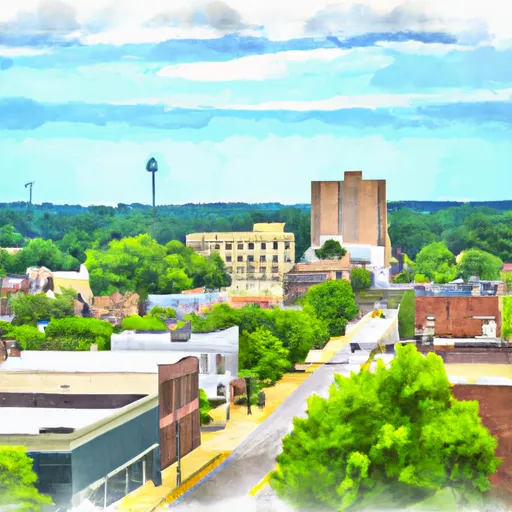-
 Snoflo Premium
Snoflo Premium
Get unlimited access to all our content
With no Ad interruptions! - Start Your Free Trial Login with existing account
Rochelle
Eden Index
Climate
8.2
•
Recreation
1.3
•
Community
2.1
•
Safeguard
4.3/10

Rochelle, Georgia is a charming city located in Wilcox County, in the southwestern part of the state. The climate in Rochelle is classified as humid subtropical, characterized by mild winters and hot, humid summers. Average temperatures range from the high 30s to mid-40s in winter, and the mid-70s to mid-90s in summer. This makes Rochelle an ideal destination for outdoor activities throughout the year.
Hydrologically, Rochelle is surrounded by several bodies of water, including Turkey Creek and the Ocmulgee River. These waterways offer great opportunities for fishing, boating, and other water-based activities. Anglers can expect to catch various fish species, such as bass, catfish, and bream. The Ocmulgee River also provides a beautiful backdrop for kayaking or canoeing.
For outdoor enthusiasts, Rochelle boasts stunning natural landscapes and parks. The Ocmulgee Wildlife Management Area, located nearby, offers hunting, birdwatching, and hiking trails. Additionally, residents and visitors can explore the Ocmulgee River Water Trail, which stretches for miles and showcases the beauty of the region's flora and fauna.
In conclusion, Rochelle, Georgia, with its pleasant climate, abundant water resources, and diverse outdoor recreational opportunities, is a fantastic destination for nature lovers and those seeking to experience the beauty of the great outdoors.
What is the Eden Index?
The Snoflo Eden Index serves as a comprehensive rating system for regions, evaluating their desirability through a holistic assessment of climate health, outdoor recreation opportunities, and natural disaster risk, acknowledging the profound impact of these factors on livability and well-being.
Climate Health Indicator (CHI): 8.2
Rochelle receives approximately
1182mm of rain per year,
with humidity levels near 85%
and air temperatures averaging around
19°C.
Rochelle has a plant hardyness factor of
8, meaning
plants and agriculture in this region tend to thrive here all year round.
By considering the ideal temperature range, reliable water supplies, clean air, and stable seasonal rain or snowpacks, the Climate Health Indicator (CHI) underscores the significance of a healthy climate as the foundation for quality living.
A healthy climate is paramount for ensuring a high quality of life and livability in a region, fostering both physical well-being and environmental harmony. This can be characterized by ideal temperatures, reliable access to water supplies, clean air, and consistent seasonal rain or snowpacks.
Weather Forecast
Streamflow Conditions
Suwannee
Area Rivers
Suwannee
Snowpack Depths
Suwannee
Reservoir Storage Capacity
Suwannee
Groundwater Levels
Recreational Opportunity Index (ROI): 1.3
The Recreational Opportunity Index (ROI) recognizes the value of outdoor recreational options, such as parks, hiking trails, camping sites, and fishing spots, while acknowledging that climate plays a pivotal role in ensuring the comfort and consistency of these experiences.
Access to outdoor recreational opportunities, encompassing activities such as parks, hiking, camping, and fishing, is crucial for overall well-being, and the climate plays a pivotal role in enabling and enhancing these experiences, ensuring that individuals can engage in nature-based activities comfortably and consistently.
Camping Areas
| Campground | Campsites | Reservations | Toilets | Showers | Elevation |
|---|---|---|---|---|---|
| Central City Park - State Fairgrounds | None | 295 ft | |||
| Parks Ferry | 85 | 582 ft | |||
| Hard Labor Creek State Park | None | 713 ft | |||
| Oconee River | 5 | 561 ft | |||
| Reed Bingham State Park | None | 203 ft | |||
| Lake Sinclair | 61 | 335 ft | |||
| Paulk City Park | 25 | 335 ft | |||
| Warner Robins AFB Military | None | 348 ft |
Catastrophe Safeguard Index (CSI):
The Catastrophe Safeguard Index (CSI) recognizes that natural disaster risk, encompassing floods, fires, hurricanes, and tornadoes, can drastically affect safety and the overall appeal of an area.
The level of natural disaster risk in a region significantly affects safety and the overall livability, with climate change amplifying these risks by potentially increasing the frequency and intensity of events like floods, fires, hurricanes, and tornadoes, thereby posing substantial challenges to community resilience and well-being.
Community Resilience Indicator (CRI): 2.1
The Community Resilience Indicator (CRI) recognizes that education, healthcare, and socioeconomics are crucial to the well-being of a region. The CRI acknowledges the profound impact of these elements on residents' overall quality of life. By evaluating educational resources, healthcare accessibility, and economic inclusivity, the index captures the essential aspects that contribute to a thriving community, fostering resident satisfaction, equity, and social cohesion.

